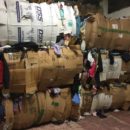The global trade of secondhand clothing is valued in the billions. And locally, clothes that don’t sell in thrift shops are often gathered up and offered for sale to consumers around the world. But as that market falls apart, secondhand shops are taking an unexpected financial hit.

When the Brattleboro, Vermont, thrift shop Experienced Goods changes its store window display every couple months, the staff sometimes hears back that the display provides pedestrians with a daydream moment. But, when the window changed in January, the thrift shop was surprised by the buzz they created by heaping — literally — a ton of donated clothes in their window.

“There is a big pile of unsalable textiles. Basically clothing, blankets, things like that that are ripped or dirty or stained, just something that you wouldn’t pay a couple bucks for in a thrift store,” says Ellen Graham, the assistant store manager at Experienced Goods, which raises money for hospice.
The special display was Graham’s idea, to bring attention to an issue that affects all secondhand shops. She says four tons of clothing a month goes unsold.
“That’s something to think about, isn’t it?” Graham laughs.
The store used to be able to recycle those “unsellables”– and do better than break even. Used to.
“Well, basically, the price of textiles has gone from…the number was 16 and a half cents down to two cents a pound. So when you take in all the other costs including keeping it somewhere and moving it around, it’s just not profitable anymore for the people we were working with to do it,” Graham says.

For the last nine years, Southern Vermont Community Action (SEVCA) collected the textiles from Experienced Goods and other thrift shops, and transfer stations.
In a Bellows Falls warehouse, the clothes are compacted into giant half ton blocks to be eventually shipped overseas. SEVCA’s Steve Geller says they scaled their collections back gradually over the past year as the market prices got softer.
“So we started to cut down on it, thinking that would help us ride it out until the prices went up,” Geller says. “And the short of it is that the prices never went back up and they kept going down. And we finally said, we don’t see any signs this is going to turn around, and we have to…cut our losses at this point.”
Geller is shipping out one final truckload of old clothes and then shutting down the recycling program.
So why is Southern Vermont having issues recycling textiles?
“What Vermont’s experiencing is really indicative of what’s going on across the country,” says Eric Stuben, with the Secondary Materials And Recycled Textiles Association (SMART). “Vermont might be a little bit more removed, in that, you know, there’s a smaller population and the rural nature of Vermont probably leads to higher logistics costs…which’re why the prices are even a little bit south of what I’m hearing out there in general.”

Stuben says the bottom just fell out of the recycled materials markets — including what the industry calls mixed institutional rags.
“It really mostly ties into two factors,” he says. “Weak economic demand from overseas and strong U.S. dollar.”
In Massachusetts, the market price that Goodwill Industries of the Pioneer Valley receives is just as bleak as the price in Vermont, according to the non-profit’s Mary Cassidy. But a major operation like Goodwill has options that many independent thrift stores do not.
If donated clothes don’t sell in their main stores, “then they go to our outlet store where things are mostly sold by the pound or by the pallet. And then if they don’t sell there then they go into our warehouse for salvaging,” Cassidy says.
Back on Flat Street in Brattleboro, Ellen Graham at Experienced Goods is thinking about what to do with the ton of textiles in her window display. She says she’ll have to throw much of it out — and that’s not free.
“We’re probably going to have to double the amount of dumpster pickups we have,” Graham says. “We’re still not sure how much that’s going to cost us. What we’d really like is for people to be more mindful about what they bring and only bring us things that they feel are saleable.”
In other words, keep those nasty off-white t-shirts to yourself.

